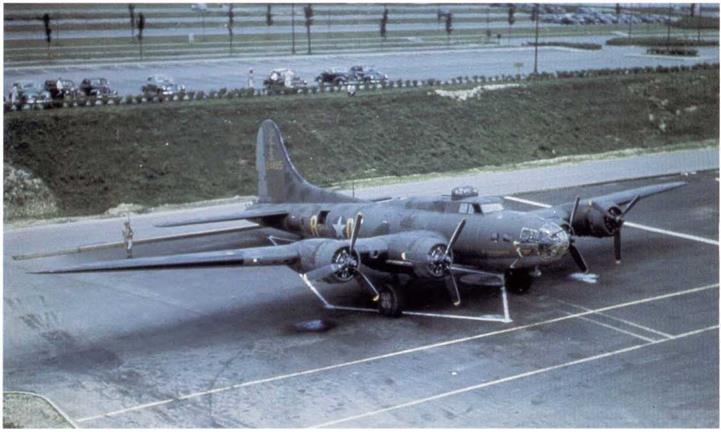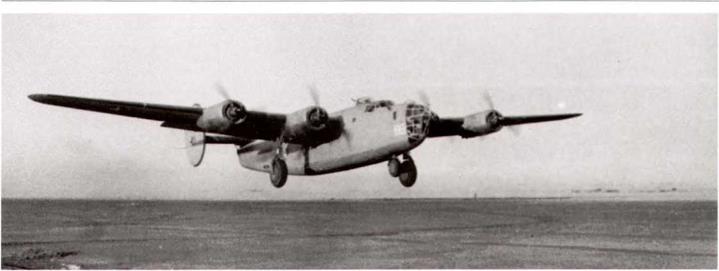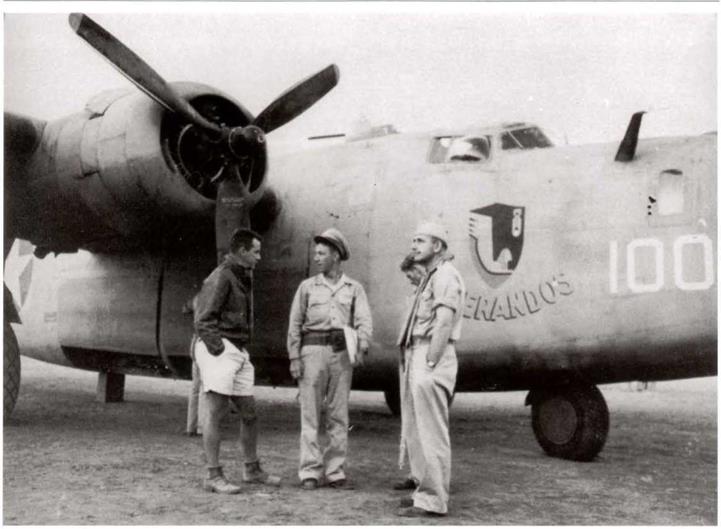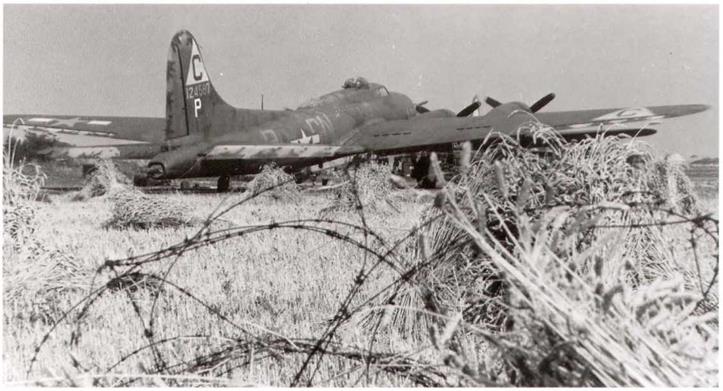T. O. 07-1-Ш changes National Insignia outline border color to Insignia Blue, September 24,1943, to agree with the new issue of AN-I-9b
The National Insignia was revised in T. O, 07-1-ID, to require the use of a BLUE BORDER in lieu of the RED BORDER formerly specified.
The work was to be accomplished as soon as possible and not later than the next 25-hour inspection by service activities with the aid of sub-depots, if necessary.
The newT. O. changed all previous references to the RED BORDER to one of BLUE. The new insignia was to now consist of a five – point, white star within a blue circle, as previously specified, together with the two white rectangles, this entire design to be circumscribed by a BORDER of BLUE whose width was 1/8 the radius of the original blue circle. Existing insignia could be reworked by painting over the existing red border with insignia blue, shade No. 47.
|
Boeing B-17F-10-BO, 41-24485, aircraft DF-A “Memphis Belle" of the 324th BS, 91st BG, back in the USA fora war bond tour. Note large amount of medium green blotches on the fuselage, and the armed guard. (USAF via Gerry R. Markgraf) |
|
Consolidated B-24D of the 376th BG, Ninth Air Force, returning to its base near Bengazi, Libya, after the August 1,1943, attack on the Ploesti oil fields in Rumania. It is finished in sand no.49 and neutral gray, with the yellow outline cocarde and RAF fin flashes. (March AFB Museum) |

The order for the revised insignia went out to industry very quickly, where it was required that the changeover should be made at the factories and mod centers as quickly as possible without delaying deliveries. For example, this revision reached Douglas Aircraft at Long Beach and Santa Monica, and Lockheed Aircraft at Burbank on September 29, 1943.
It should be noted that the Navy moved even faster, sending out the change on September 23,1943, one day before the issue of T. O. 07-1- ID. In fact, their teletype was dated September 15,1943, but its transmission was apparently delayed by coordination with the AAF.
New’ ANA BULLETIN No. 157 standardizes names and numbers of Army-Navy colors for aircraft camouflage, September 28, 1943.
The results of the JAC standardization of aircraft camouflage colors was finally issued on September 28, 1943, as ANA Bulletin No.157. This listed the following:
COLOR NO. COLOR NAME
601 Insignia White
602 Light Gray
603 Sea Gray
604 Black
605 Insignia Blue
606 Semi-Gloss Sea Blue
Two Consolidated B-24Ds of the 376th BG, shortly after their return from the Ploesti mission. The nearest aircraft is 4І-П630, aircraft no.83. Note that the RAF fin flashes are on both sides of the vertical tail. (March AFB Museum)
|
Consolidated B-24D, aircraft no. 100 of the 376th BG. Brig. Gen. II. G. Ent, CG of the Ninth Air Force Bomber Command, is on the extreme right of the group, in front of the B-24D. This sand and neutral gray Finished aircraft had the yellow outline cocarde, is the one the general flew in on the attack on Ploesti. (March AFB Museum) |
|
6G7 |
Non-Specular Sea Blue |
|
608 |
Intermediate Blue |
|
609 |
Azure Blue |
|
610 |
Sky |
|
611 |
Interior Green |
|
612 |
Medium Green |
|
613 |
Olive Drab |
|
614 |
Orange Yellow |
|
615 |
Middlestone |
|
616 |
Sand |
|
617 |
Dark Earth |
|
618 |
Dull Red |
|
619 |
Insignia Red |
Note 2a. of the original document stated that:
The Arm у-Navy Aircraft Camouflage Color Standards supersede Army Air Forces Bulletin No. 41 and any other color standards for the colors listed herein for Army and Navy aeronautical use.
For many reasons, these new color standards did not take effect for several months. For example, the engineering department at Douglas Aircraft Co’s. Santa Monica plant did not receive their copy until October 30, 1943. However, the main reason was it took several months before the necessary camouflage paint specifications were revised to meet the requirements (for full details see Chapter 7). Also note that there were no high altitude camouflage colors included, despite the request of August 13, 1943, to the Tech. SubCommittee on Camouflage.
|
Boeing B-17F-27-BO, 41-24587, is aircraft GN-P of the 427th BS, 303rd BG. It is seen at its base at Molesworth, England, on September 11, 1943. It has the medium green blotches and carries the new 1st Bomb Wing triangle on the tail. The code letters are in gray and the insignia has the new blue outline. (USAF) |
None of the colors in the Bulletin were changed, except for the major one of color No. 613, Olive Drab. This replaced the previous Dark Olive Drab No. 41 of Bulletin No. 41, per the Army request of January 22,1943 (described earlier). There was quite a difference in the shade of the two colors, but in the event, the change was not to appear in the combat theaters for many months, and as it so happened, not on the AAF major combat aircraft. This was because, as a result of Gen. Arnold’s inquiries to his theater commanders (described earlier), far-reaching changes were about to be made in the AAF camouflage requirements.














